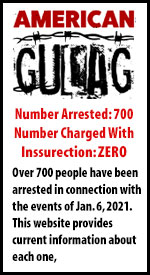WHO Moves to Seize Control of Global Food Supply

The World Health Organization (WHO) has taken significant steps to seize control of the global food supply.
The WHO, the United Nations’ “health” agency, is pushing to establish an “alliance” that will allow the unelected organization to monitor and control the food supply of sovereign nations around the world.
Last week, the WHO Alliance for Food Safety concluded its first meeting where bureaucrats laid out plans for establishing global governance of the food supply.
The meeting included UN organizations, WHO collaborating centers, corporate elites, and wealthy donors.
Globalists convened for the meeting to discuss the implementation of the “WHO Global Strategy for Food Safety 2022–2030.”
According to the WHO and its allies, controlling the food supply for the general public is essential for “fighting climate change” and tackling the “next pandemic.”
The alliance will have authority over what food is being produced.
It will also control how the food will be produced, managed, and inspected, and where it will be distributed.
This new plan uses the UN’s One Health approach.
One Health uses fear to control populations and justify the restriction, impoverishment, and death of the public.
The plan is baked into WHO’s proposed amendments to the International Health Regulations and Pandemic Treaty.
The moves come as the UN, the WHO’s parent agency, is preparing to position itself as the Single World Government.
On May 6 to 8 2024, the WHO Nutrition and Food Safety Department hosted the first meeting of the WHO Alliance for Food Safety.
The meeting was organized in collaboration with the U.S. Centers for Disease Control and Prevention (CDC).
The meeting aimed to support the implementation of the “WHO Global Strategy for Food Safety 2022–2030.”
The Strategy was adopted at the 75th Session of the World Health Assembly in May 2022.
It was planned that the implementation of the Strategy takes place over 8 years from 2022 to 2030, hence the years stated in its title.
WHO’s Strategy sets global food “safety” targets to be reached by 2030.
“Currently, there is no global mechanism in place to align efforts in this area and to provide innovation and support to countries in a coordinated way,” WHO states.
In an effort towards filling the perceived gap, WHO convened the WHO Alliance for Food Safety meeting to:
- develop the terms of reference of the WHO Alliance for Food Safety, identifying its added value in the area of foodborne diseases surveillance; and,
- develop a draft work plan for 2023 – 2030 to help countries meet the WHO target of foodborne disease surveillance by 2030.
In a statement in the preceding days, WHO said it was hoping that 64 WHO collaborating centers, UN organizations working in food safety, and donors would attend the meeting.
In the Strategy, the WHO offers two justifications for implementing global food safety control.
One is the prevention of diseases caused by food hygiene and the other is meeting the targets of the UN’s globalist “climate change” agensa – Sustainable Development Goals (SDGs).
“Unsafe food containing harmful levels of bacteria, viruses, parasites, chemical or physical substances can cause acute or chronic illnesses – including more than 200 diseases ranging from diarrhea to cancers, which in some cases, leads to permanent disability or death,” the executive summary states.
“Food safety remains a public health priority with a critical role in the 2030 Agenda for Sustainable Development,” it adds.
This new strategy, according to the executive summary, will contribute to the achievement of the SDGs.
It will be reviewed in 2030 when the world will reflect on the progress made towards the SDGs.
There has been much focus in independent media in recent years on Agenda 2030 and many have become familiar with its nefarious aims.
But possibly fewer realize that the UN’s Agenda 21, from which Agenda 2030 springs, covers the entire 21st century.
In other words, Agenda 2030 covers the decade up to the year 2030.
Agenda 2040 covers the decade that follows.
This is then followed by Agenda 2050 and so on until the final decade and the final Agenda 2090 ending in the year 2099.
We should not be surprised then when we see a reference to “the world will reflect on the progress made” in 2030.
According to the executive summary: “The Strategy recognizes that the safety of food is closely linked to the health of animals, plants, and the environment within which it is produced.”
This is the One Health approach.
The executive summary continues:
“The Strategy calls [WHO’s] Member States to consider the One Health approach when planning the implementation.
“This will allow national governments to detect, prevent, and respond to existing and emerging diseases at the human-animal-environment interface and to rapidly respond and mitigate food-related public health issues resulting from these interactions.”
WHO’s Strategic Priorities
Starting on page 9, the executive summary describes the Strategy’s five “strategic priorities.”
“Member States should modify, redesign or strengthen their national food safety systems as appropriate based upon the strategic priority areas and strategic objectives identified in the strategy,” the document states.
The first of WHO’s priorities is “strengthening national food control systems.”
Although the word “control” is shown in the title, it is replaced with the friendlier-sounding word “safety” throughout the executive summary.
We can assume, as they have form, that this is so their plan appears benign.
However, an overview of “Strategic Priority 1” (see below) clearly demonstrates the aim is control and not “safety.”
In addition to having legislation, policy, institutional frameworks, and control functions in place, the executive summary says, WHO’s Member States need to consider and adopt four important principles for the system to be more effective.
The executive summary describes these principles as:
- Forward-looking – “Strategic Priority 2: Identifying and responding to food safety challenges resulting from global changes and transformations in food systems.” Food safety systems should be equipped to identify, evaluate, and respond to existing and emerging issues. The food safety systems must be transformed from reactive to proactive systems, especially when addressing health risks emerging at the human-animal-ecosystems-environment interface.
- Evidence-based – “Strategic Priority 3: Increasing the use of food chain information, scientific evidence, and risk assessment in making risk management decisions.” The collection, utilization, and interpretation of data lay the foundation for building evidence-based food safety systems.
- People-centered – “Strategic Priority 4: Strengthening stakeholder engagement and risk communication.” Successfully ensuring food safety from farm to fork requires a more inclusive approach with all stakeholders, including empowered consumers and food business operators (FBOs).
- Cost-effective – “Strategic Priority 5: Promoting food safety as an essential component in domestic and international food trade.” With the globalization of the food trade, foodborne pathogens and diseases can travel across borders and cause significant health and economic impacts.
UN’s Control of National Food Control Systems
To demonstrate the complete control of food supplies by the UN and its agencies, while also implementing the One Health approach, we quote the following from the executive summary (links added).
The general approach for Member States to develop, update and implement their national food safety strategies is summarised in [the figure below].
For the situation analysis, the tool developed by FAO and WHO can be used to assist Member States in evaluating the effectiveness of their food control systems, whatever the level of its maturity. This tool can be used to evaluate the status of the national food control system, to identify strengths and weaknesses, and to identify priority areas for action.
Besides this FAO/WHO tool, the Joint External Evaluation and Electronic State Parties Self-Assessment Annual Reporting Tool under the WHO International Health Regulations can also be utilised to assess the national food safety preparedness capacity.
Additionally, the World Organisation for Animal Health (WOAH) Performance of Veterinary Services (PVS) Pathway specifically targets the safety assessment of production and processing of food of animal origins.
Once a baseline assessment of the national food safety system has been carried out, it will be possible to define objectives and target interventions to strengthen the system based on the five strategic priorities [sic] areas identified in this strategy.
WHO Global Strategy for Food Safety 2022–2030: Executive Summary, World Health Organisation 2022, pg. 15
The situation analysis should be followed by the development of an implementation plan that includes the sequence for different elements of the restructured food safety system to be applied, the definition of roles and responsibilities, and the establishment of a monitoring and evaluation system. The plan needs to be properly resourced and financed to accomplish its objectives.
Once the plan is agreed and communicated, the implementation phase can begin. Regular progress checks and reports should form a part of the regular monitoring to ensure the plan remains on course or that appropriate course correction measures are applied.
Together with other international partners, WHO will support Member States by providing global leadership … WHO and FAO will develop a joint monitoring framework aligning [the countries’] food safety strategies [Emphasis added]
WHO Global Strategy for Food Safety 2022–2030: Executive Summary, World Health Organisation 2022, pg. 16
“The plan needs to be properly … financed to accomplish its objectives,” the document urges.
Conveneintly, the WHO fails to mention who will be paying for the scheme.
However, the burden for these globalist plans will fall on taxpayers.
The WHO continues by explaining how it plans to monitor and control the food supply on a global scale:
Underpinning the updated strategy will be an accountability framework to measure the rate of implementation. The updated strategy encourages Member States to select indicators and set targets at the national level to evaluate the effectiveness and appropriateness of national food safety systems … A global mechanism will also be established to measure the progress of the strategy using a set of global indicators and targets. The updated version of the strategy contains three global indicators:
- diarrhoeal diseases due to contaminated food consumption;
- multisectoral collaboration mechanisms for food safety events; and
- surveillance of foodborne diseases and contamination.
The first indicator is evaluated on an ongoing basis by WHO’s Foodborne Disease Burden Epidemiology Reference Group. The second and third above mentioned indicators are already monitored and measured regularly through the International Health Regulations (2005).
WHO will develop a framework to monitor implementation and to validate the progress made towards these global targets.
WHO Global Strategy for Food Safety 2022–2030: Executive Summary, World Health Organisation 2022, pg. 16 and 17
The moves come amid increasing efforts from unelected globalist forces to destroy the farming industry and eliminate meat and dairy consumption.
Once the WHO takes control of the food supply, it’s easy to predict what will happen to traditional agriculture.





















